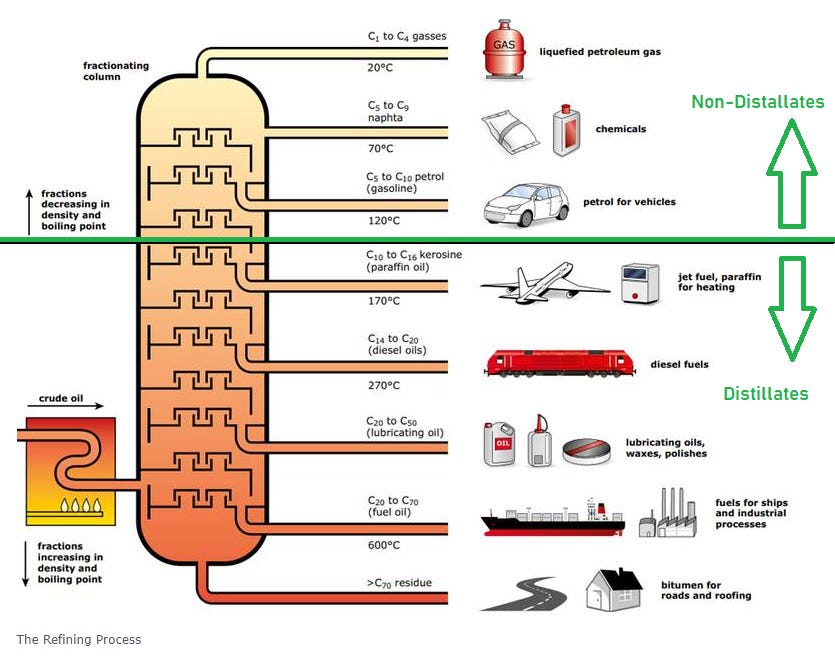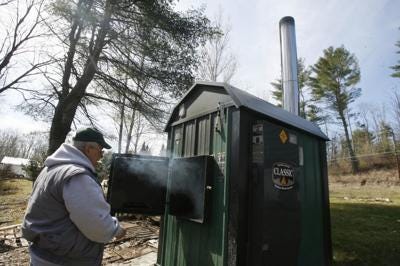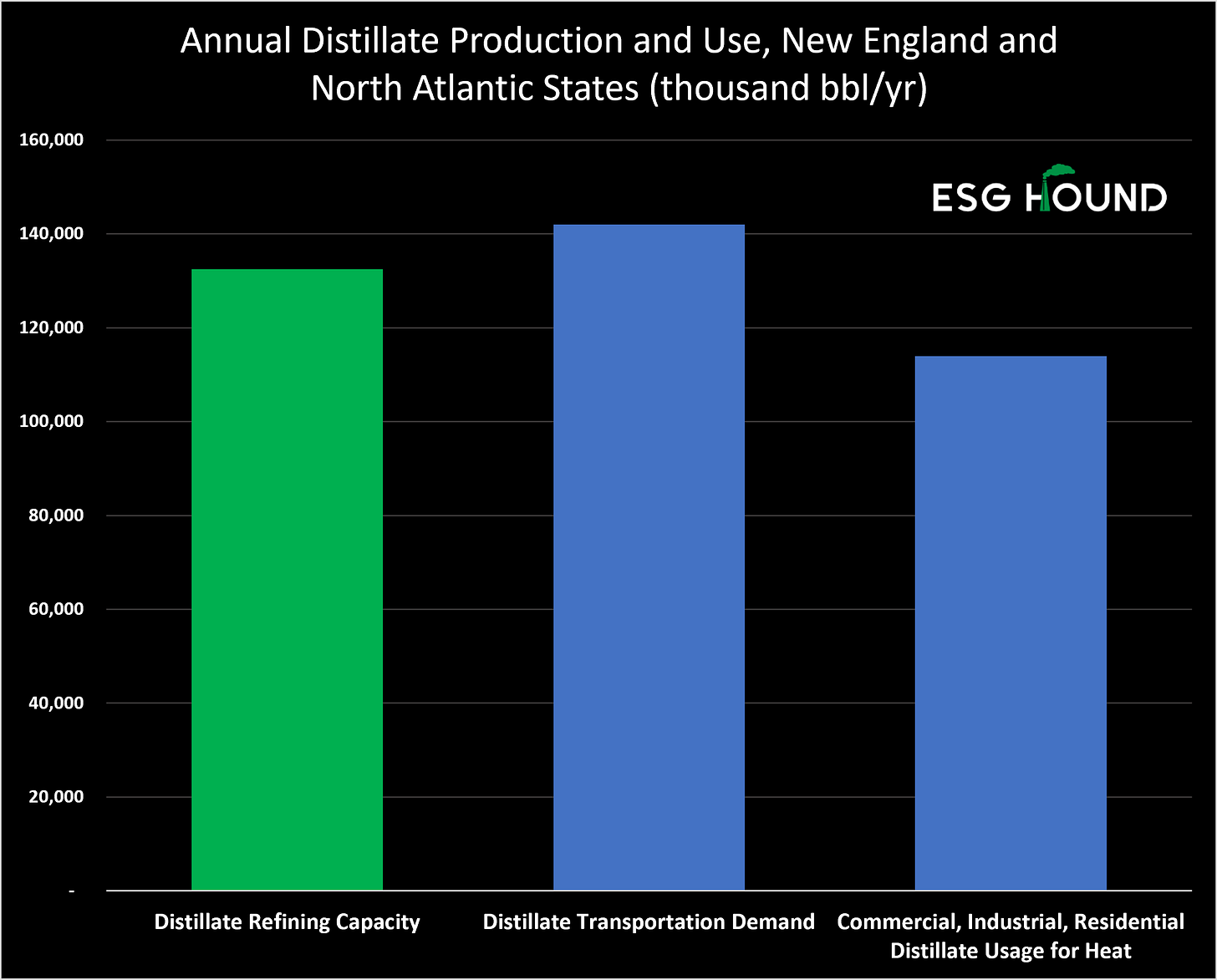New England's Distillate Oil Addiction is a confluence of policy failures
A choice: Nuclear, Natural Gas or Heavy Oil?
Much has been written about the current commodity issues that are working their way through the global financial system. Like a buffet shrimp eaten a few hours after it should’ve been tossed, the rumbling tummy of global commerce is signaling that a reckoning is near on the horizon. From lumber to steel, fertilizer to oil, some of the changes taking place are breathtaking. INFLATION! STARVATION! ENERGY CRISIS!
I’ve enjoyed, tremendously, the recent writings of fellow substacker Doomberg. He’s a friend of mine, and he’s beaten me to the punch on several ideas that were on my list of to-do’s. I’m still sore that the little green chicken got to write about Ethylene Oxide as the building block of everything we consume before I did. Doomberg and I don’t see eye to eye on every policy decision, but he does have one admirable trait that is far too uncommon among serious sustainability writers:
There’s never a perfect choice. Everything is a tradeoff.
So as a launching point for this piece, I’d like you to take a look at his recent piece on the ongoing energy crisis in New England:
In particular, this graphic is one to focus on
In Southern States, residential, commercial, and light industrial power use spikes in the summer, as A/C units run every hour of the day. The exact opposite is true in New England and the rest of the Northeast. Total energy use, be it BTUs of fossil fuels combusted or Megawatt Hours delivered by nuclear is highest in the coldest months of winter.
New York famously banned fracking in their state. Gas pipelines have been a non-starter, even those that replace aging lines from the 1950s with pipes less likely to explode. And look, I get it. Climate change is real. We’re not really doing anything about it. People have never liked pipelines near them. It’s a reasonable personal position for most to take. But when we talk about energy policy, we have to live in the world of reality.
Here are the facts:
It gets cold in the Northeast
We need a way to heat businesses and homes in the winter
Combusting fossil fuels to create electrical power has built-in inefficiencies; 30% of the heat from combustion is lost. On the flip side, efficiency losses from converting electricity to heat are technically 0% but the heat up and cool down times for resistive heaters effectively makes them unworkable for many industrial heating purposes and causes a net loss of efficiency of 10-20% when used for residential purposes1. Burning coal to make electricity and then using that electricity for heat is an insane use of fossil fuels, especially if another option is available.
If we’re gonna burn carbon2, it should be for making heat.
This brings us back to Doomberg’s dilemma:
If we’re killing nuclear (we are) and we need to have heat and power (we do), where does that come from in the American Northeast? The solutions are:
Solar Power
Wind Power
Coal Power
Natural Gas Heaters
Distillate Oil Heaters
I’d like to think that we can rule out solar in any sort of reasonable timeframe (more on that later). Gray, cloudy snowy latitudes in the middle of the winter, when days are short, isn’t exactly where solar shines.
Wind is a bit better, but New England doesn’t have the expansive blustery prairies and deserts that make West Texas and Iowa such ideal regions for it. The recently approved Vineyard Wind 1 Project off of Nantucket (which comes with its own environmental warts on fishing habitats) will generate enough power in a year at 100% capacity to offset residential fossil fuel combustion for… the entire State of New Hampshire3, population 1.4 million. That’s not electricity for those homes, just fuel burned in residential air exchange heaters.
With coal ruled out (for very obvious reasons) that leaves us with Natural Gas and Distillate oil. Given the context provided by Doomberg, this next chart should come as no surprise:

New England has chosen to continue to burn distillate oil. To a somewhat lesser extent, so has the New York Metro area, the Greater Baltimore area and The Greater Philadelphia Area. Pennsylvania is number 8 on the list, despite the western half of the state being a prolific natural gas producer, as the Eastern portion burns distillate oil like it’s going out of fashion.
Now these states face skyrocketing energy costs. I’ve grouped the Upper Atlantic States with New England into a broad Northeast for the exercise for a few reasons. For one they’re all in the same PADD region, per IEA.
In addition, the refineries in this region are almost entirely Ship In, Ship Out. Input crude comes to the region largely by Jones Act Tankers and it leaves via ship or by tanker truck and rail. Finished fuels come largely via ship to the major ports in Baltimore, Virginia, Boston and New York from the Gulf Coast. There are some Jet/Diesel/Gasoline pipelines as well.
Let’s talk about distillates

Refining oil is an insanely complex process, but we’re going to keep it simple here. Crude oil enters primary atmospheric distillation (the first step after de-watering) and comes out in fractions based on the density or API gravity of the various hydrocarbons. Much of the stuff on the bottom can be processed primarily through distillation alone. Catalytic cracking allows you to go from longer hydrocarbons to shorter hydrocarbons. For this purpose, we’re going to talk about light ends (gasoline and napthas) vs distillates.
What this chart tells us is that the Northeast’s refining capacity for distillates is already more than accounted for by use in transportation. Which means every single drop of fuel oil burning in homes and businesses in the region is effectively brought in via Tanker ship. There’s no use it or lose it capacity in the refining sector.
But we hate pipelines, right?
That brings us to our old friend Natural Gas. Natural gas burns cleaner and more efficiently than fuel oils. Its carbon footprint is lower. It emits less CO, NOx, CO2 and VOC per BTU of heat provided.
Since we know that there is no use it or lose it capacity in Northeastern refining, let’s pretend we flipped a switch and every single drop of fuel oil used for heat was converted to natural gas. This is approximately 500 Jones Act tanker trips to the region every year, assuming a cargo capacity of 30,000 tons.
NOx is the primary driver of ground level ozone, one of the remaining “criteria” pollutants. I estimate that approximately 17,000 tons of NOx will be reduced as a result. A single car emits about 20 lb of NOx per year, meaning that the distillate to natural gas change would effectively remove 1.8 million cars worth of NOx emissions.
Climate impacts are interesting.
The states mentioned have deployed a total of 14,000 Megawatts of Solar Capacity, at a cost of $6-8 Billion in ITC credits. This amount offsets approximately 10 million tons of CO2e per year assuming all power displaced was coal. Impressive, right?

It turns out that even if we add a 10% penalty to the GHG lifecycle calculation for natural gas to account for methane leakage not present in current climate models, once transportation, refining and extraction are added up, switching regional distillate heat to natural gas saves nearly 20 million tons of GHG emissions every year.
Again, I want to emphasize that I’m not preaching natural gas as some sort of moral imperative. The need for energy when the sun doesn’t shine in cold climates means we have to make hard choices. Personally, I’d like to look more at nuclear as a long term solution. It’s striking that, when these decisions need to be made, liberal ole New England’s addiction to distillate fuel to keep basic functions of society afloat seems kind of… short sighted, no?
Thanks for reading and please subscribe! 👇
People get really mad about this but it’s a fact. Example: When you take a pot off of a conventional electric cooktop and turn the burner off, the heat radiating from the coil is wasted. A gas cooktop will retain some heat after shutoff, but about 95% less. But I digress
Wood for heat might feel more natural, but it’s incredibly inefficient and dirty
24 Trillion BTU/year in 2019 per EIA











New England summers are getting warmer too so there is a bigger demand for cooling now than in the past 30 years. Heat Pumps that can both heat/cool could be viable solutions to the problem provided the strain on the grid is acceptable.
Further, many of the homes in the New England area were built before there was access to affordable insulation. I've heard of some houses being insulated with crumpled newspaper.
Insulation works for keeping houses cool in the summer as well as warm in the winter. Mass Save is a good program, but we need similar programs for NH, VT, and Maine too.
Offshore wind will happen eventually but the problem is ultimately NIMBYism. I think there is a lot of opportunity in Maine for offshore as the state needs quality high paying jobs as lobsters migrate north due to warming waters.
Great post!
heh, I read the first para wondering what you and Doomberg would make of each other, then I got to the second ;-)